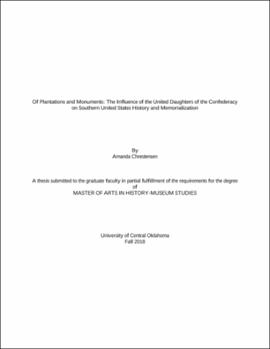| dc.contributor.advisor | Vaughn, Heidi | |
| dc.contributor.author | Chrestensen, Amanda L. | |
| dc.date.accessioned | 2020-07-09T14:41:48Z | |
| dc.date.available | 2020-07-09T14:41:48Z | |
| dc.date.issued | 2018 | |
| dc.identifier.other | (AlmaMMSId)9982642670802196 | |
| dc.identifier.uri | https://hdl.handle.net/11244/325149 | |
| dc.description.abstract | This thesis evaluates the United Daughters of the Confederacy's (UDC) interpretation of Southern history through the mediums of textbooks, youth groups, and Confederate monuments in public spaces and how this interpretation affects the way historical plantations present antebellum history today in Louisiana. Many plantation sites along the River Road in Louisiana either annihilate or trivialize the history of enslavement. Instead they focus on landscape, architecture, or the slave-owning family. My research discusses why the slave narrative is absent or used in a trivializing manner and how the UDC influenced these outlooks. Many of the sites mirror aspects of the Lost Cause theory which the Daughters perpetuated throughout the southeast United States. This thesis also evaluates the meaning and appropriateness of Confederate memorials sponsored by the UDC in public spaces. This thesis is structured in four main chapters following an introduction. The first chapter explores the present literature on the United Daughters of the Confederacy and the unwavering devotion some American citizens have for the former Confederate nation. The chapter explains the Lost Cause theory, the idea that the Confederacy was destined to lose the Civil War due to a lack of resources, yet gallant and brave white men went to war anyways to defend their freedoms. The theory also includes the idea of happy slaves who were content with a life of bondage and supported the Confederacy. The second chapter assesses the early efforts made by the UDC and the legacy they nurtured in young children. It discusses the creation of the apolitical group and their role as memory keepers for the deceased and defeated. The chapter also explores the actions taken by the Daughters to promote the Lost Cause theory and their ideas and values to children through textbook reform and youth groups. The third chapter evaluates the way some plantation museums along the River Road in Louisiana interpret antebellum and slave history. It compares historical sites that are publicly owned versus sites that are privately owned, either for profit or nonprofit. The distinction is necessary because publicly owned sites have a moral responsibility to the tax payers to provide an inclusive history. The final chapter discusses the meaning and placement of Confederate memorials in public spaces such as court houses, schools, and parks. The UDC sponsored many of the monuments. The chapter looks at the era they were established, the location, and the meaning behind the inscription to prove the UDC erected the monuments to further their white supremacist and Confederate agenda. | |
| dc.rights | All rights reserved by the author, who has granted UCO Chambers Library the non-exclusive right to share this material in its online repositories. Contact UCO Chambers Library's Digital Initiatives Working Group at diwg@uco.edu for the permission policy on the use, reproduction or distribution of this material. | |
| dc.subject.lcsh | Plantations | |
| dc.subject.lcsh | Slavery | |
| dc.subject.lcsh | White nationalism | |
| dc.subject.lcsh | Monuments | |
| dc.title | Of plantations and monuments : the United Daughters of the Confederacy and their influence of Southern history and memorialization. | |
| dc.type | Academic theses | |
| dc.contributor.committeeMember | Huneke, Erik | |
| dc.contributor.committeeMember | Lacher, Katrina | |
| dc.thesis.degree | M.A., History - Museum Studies | |
| dc.subject.keywords | United Daughters of the Confederacy | |
| dc.identifier.oclc | (OCoLC)1099570413 | |
| uco.group | UCO - Graduate Works and Theses::UCO - Theses | |
| thesis.degree.grantor | Jackson College of Graduate Studies. | |
